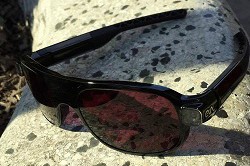New smart glasses can talk to the blind
One of the 21st century’s challenges is helping the visually impaired and the blind to navigate around their surroundings so they can benefit from a better quality of life. While medical advances have improved treatment for many who are visually impaired, those who cannot be helped medically can benefit from artificial intelligence and assistive technology in ground-breaking ways. Going beyond dogs and canes The EU-funded EVA project developed voice-controlled eyewear for the visually impaired. EVA, which stands for ‘Extended Visual Assistant’, is based on machine vision that recognises objects, texts and signs, and verbally describes what it sees. “Information technology offers different solutions to the challenges faced by blind people every day,” says Mr Krisztián Imre, CEO of developing company EVA Vision and product designer of EVA. “For example, a computer can read text aloud, smartphone apps recognise objects, pictograms or colours,” he notes. Traditionally, the navigation of visually impaired people has been facilitated by canes and trained guide dogs. Canes are limited to detecting objects on ground level, while dogs can be prohibitively expensive and scarce. “Our cost-effective reliable mobility tool empowers visually impaired people to move around in a safer and more independent way, supporting a fuller and more social lifestyle,” explains Mr Imre. High-tech glasses with online connectivity When EVA researched living with blindness, it realised that mobility and transport were most problematic. “We aimed to create a lightweight wearable assistive tool that can operate as long as possible,” reveals Mr Imre. To achieve this, the team went beyond using a general-purpose operating system in favour of identifying a low-energy–consumption system that was also cost-effective. This led to a prototype set of stylish, lightweight glasses with a discrete camera, microphone, speaker and control buttons. “The EVA glasses collect and pre-process audio-visual data before sending it to the wearers’ smartphone for additional processing which can then send back audible guidance to the user,” outlines Mr Imre. An intuitive interface helps the wearer control the glasses not only through buttons on the frame but also through gestures, head movements and voice commands. A host of benefits for the blind Beyond decreasing social isolation and empowering the blind to become more autonomous, the glasses can read print material, recognise objects and vocalise the wearer’s position, creating a sense of security. “The glasses can even handle phone calls and short messages, and help compose replies,” underlines Mr Imre. In the future, the glasses will be able to alert the visually impaired about the proximity of autonomous vehicles and electric cars which are more silent. EVA technology can integrate with Cooperative Intelligent Transport Systems (C-ITS) that connect vehicles together as well as with traffic infrastructure (such as traffic lights) to improve road safety. “Traffic light status information can tell the blind when it is safe to proceed,” affirms Mr Imre. “C-ITS could potentially allow blind road users to request a green light where and when traffic management allows it,” he adds. Currently, the company is producing some 200 pre-commercial versions of the smart glasses for large-scale worldwide testing of the navigation and obstacle detection features. It will also test the glasses in European countries with the help of blind volunteers and gather the feedback to fine-tune the product. “Dissemination about the glasses will also be carried out through trade shows and conferences, as well as through partnerships with distributors, insurance companies and healthcare systems where possible,” says Mr Imre. Once commercialised, many blind people and their carers stand to benefit from this technological marvel.







